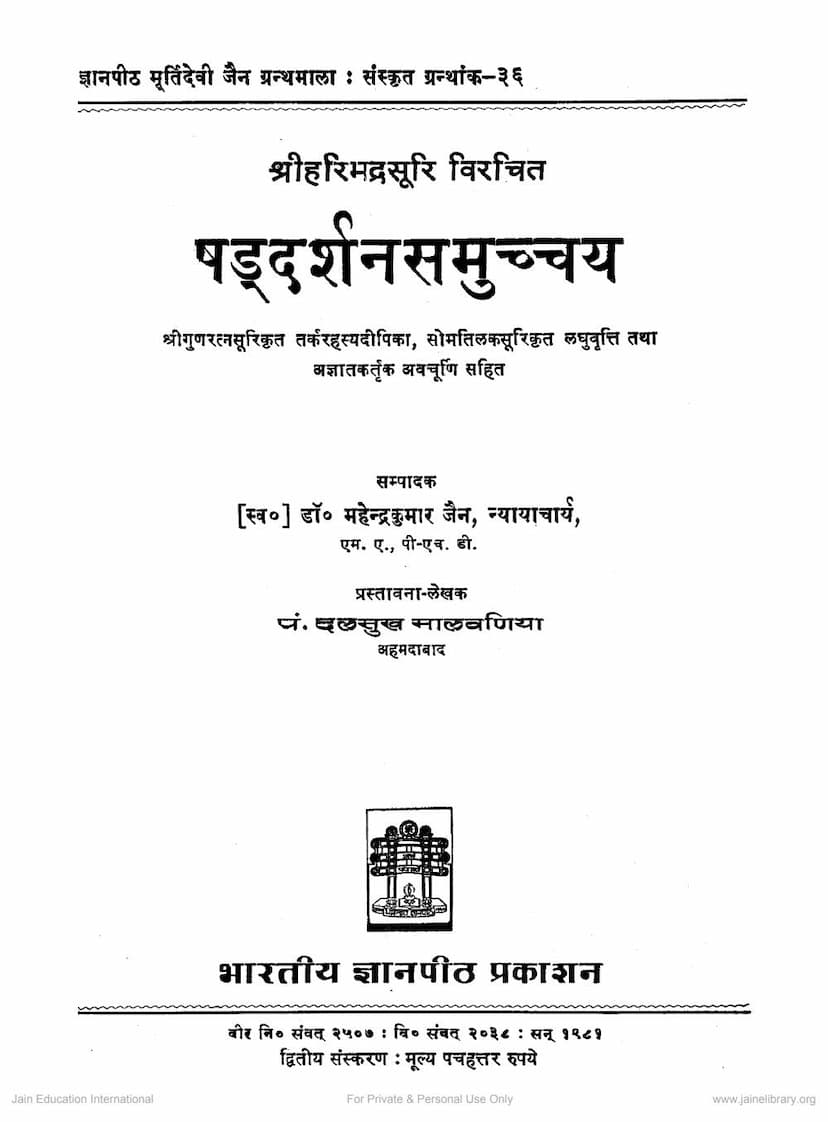Shaddarshan Samucchaya
Added to library: September 2, 2025

Summary
Here's a comprehensive summary of the provided Jain text, "Shaddarshan Samucchaya" by Haribhadrasuri, based on the translated pages:
Book Title: Shaddarshan Samucchaya (A Compendium of Six Philosophies) Author: Haribhadrasuri Commentaries: Tarka-rahasya-dipika by Gunaratnasuri, Laghu vrtti by Somatilaka Sûri, and an anonymous Avacūrni. Publisher: Bharatiya Gyanpith Publication Year: 1981 (Second Edition)
Overall Purpose and Context:
The "Shaddarshan Samucchaya" is a significant Jain philosophical text compiled by Acharya Haribhadrasuri, a renowned Jain scholar from around the 750 AD. The work aims to provide a compendium of six major Indian philosophical systems (Darshanas). The provided text is a critical edition published by Bharatiya Gyanpith, which includes valuable commentaries that shed light on the original work and the broader philosophical landscape of ancient India. The publication emphasizes Haribhadrasuri's broad scholarship, his understanding of non-Jain traditions, and his ability to present them dispassionately, often in comparison or refutation of other doctrines. He is considered a pioneer in Indian literature for creating such a comprehensive overview of different philosophical schools.
Key Aspects of Haribhadrasuri's Contribution (as highlighted in the General Editorial):
- Encyclopedic Knowledge: Haribhadrasuri's vast range of works in Sanskrit and Prakrit covered almost every subject, establishing him as a monumental figure in Indian literature.
- Jainism and Beyond: While primarily contributing to Jainism, his learning was extensive. He was the first Sanskrit commentator of the Ardhamāgadhĩ canonical texts. His commentary on Dignāga's Nyāyapraveśa shows his erudition extended beyond his religious fold.
- Mastery of Other Traditions: His works like "Dhūrtakhyana" and "Shastra Varta Samuccaya" demonstrate a great command over Brahmanic mythology and philosophical schools.
- Enrichment of Jain Doctrines: His Prakaranas showcase how he applied extensive scholarship and a fresh mind to exposition of Jain doctrines, even enriching them, as seen in his discourses on Yoga.
- Anekanta Principle: Haribhadra's mind was attuned to the spirit of Anekanta (non-absolutism or multi-sidedness of reality). He presented many Jain tenets not in isolation but comparatively, refuting other doctrines dispassionately when necessary.
- Storytelling and Teaching: He was an adept storyteller and a mature religious teacher.
- Pioneering Compendium: The "Shaddarshan Samucchaya" is considered almost the first Indian literary work to offer a compendium of the Six Darshanas.
The Six Darshanas as Enumerated by Haribhadrasuri:
Haribhadrasuri's enumeration of the six Darshanas differs from the orthodox (which typically includes Nyaya, Vaisheshika, Sankhya, Yoga, Mimamsa, and Vedanta). His comprehensive list provides an overall view of Indian religio-philosophical speculation, and includes:
- Bauddha (Buddhist)
- Naiyāyika (Naiyāyika - likely Nyaya school)
- Sāṁkhya (Sankhya)
- Jaina (Jain)
- Vaiśeṣika (Vaisheshika)
- Jaiminiya (Jaiminiya - likely Mimamsa)
The General Editorial notes that while orthodox systems often studied others primarily for criticism, Haribhadra was a notable exception who sought to provide authentic details for comparative study.
Commentaries Included:
The edition is notable for including the exhaustive "Tarka-rahasya-dipika" commentary by Gunaratnasuri, along with the "Laghu vrtti" of Somatilaka Sûri and an anonymous "Avacūrni." These commentaries are crucial for understanding the nuances of Haribhadra's original work.
Historical and Scholarly Context:
The General Editorial and Preface provide valuable context regarding the study and publication of the "Shaddarshan Samucchaya." It mentions the attention it received from Oriental scholars, citing works by F. Hall, F. L. Pulla, and L. Suali, who studied, translated, and edited the text with Gunaratna's commentary. It also acknowledges the contribution of the late Dr. Mahendra Kumar Jain, the editor, who was known for his model editions of Jaina works on Nyaya and his technique of providing comparative notes.
Philosophical Context and Haribhadra's Approach:
- Compendium Value: The practice of creating such compendiums was valuable for understanding the evolution of Indian philosophical thought, with many subsequent works following Haribhadra's lead.
- Haribhadra vs. Others: The preface differentiates Haribhadra's approach from commentators like Vachaspati Mishra. While Vachaspati often refuted opposing doctrines, Haribhadra's primary aim in "Shaddarshan Samucchaya" was to provide a mere introduction or overview.
- Inclusion of Non-Vedic Schools: Haribhadra's significant inclusion of non-Vedic schools like Buddhism and Jainism within his "Six Darshanas" is highlighted.
- Naya Siddhanta and Synthesis: The preface delves into the development of the Jain Naya Siddhanta (theory of standpoints) and how Jain philosophers, influenced by the early need to reconcile differing viewpoints within Buddhism and later by the broader Indian philosophical discourse, began to study other systems. Haribhadra's "Shaddarshan Samucchaya" and "Shastra Varta Samuccaya" are seen as outcomes of this trend, aiming to reconcile or at least understand Jain doctrines in relation to others.
- Haribhadra's Dual Role: Haribhadra is seen in two forms: a staunch sectarian writer in works like "Dhurtakhyana" and commentaries on Agamas, and a conciliatory philosopher in his metaphysical works like "Shastra Varta Samuccaya," where he integrates or reconciles opposing views.
Significance of the Edition:
This specific edition by Pt. Mahendra Kumar Jain, with Pt. Dalasukh Malavaniya's retouching and introduction, is presented as a fitting tribute to the late scholar's work and his contribution to Jainology and Indian philosophy. It underscores the importance of "Shaddarshan Samucchaya" as a manual of Indian philosophy and Gunaratna's commentary as a lucid exposition.
In essence, the "Shaddarshan Samucchaya" is a foundational text for understanding the diversity and evolution of Indian philosophy, presented through a Jain lens by the masterful Acharya Haribhadrasuri. The Bharatiya Gyanpith edition, with its extensive commentaries, makes this ancient wisdom accessible and valuable to contemporary scholars.